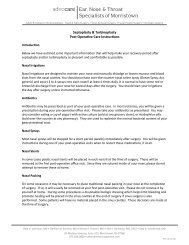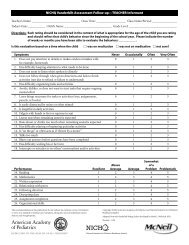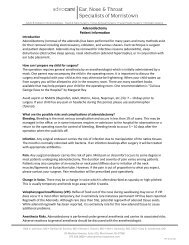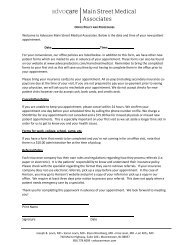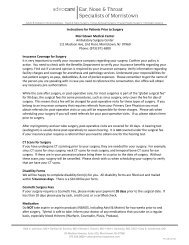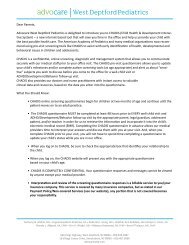Third Trimester Information (28 weeks until delivery ... - Advocare
Third Trimester Information (28 weeks until delivery ... - Advocare
Third Trimester Information (28 weeks until delivery ... - Advocare
Create successful ePaper yourself
Turn your PDF publications into a flip-book with our unique Google optimized e-Paper software.
Wendy Martinez, MD, FACOG • Donna D’Elia, MD, FACOG • JonelDershem, MD, FACOG • Paula Jasionowski, APN, C • Anne Salomone, RN-C, CNM, MS<br />
2301 Evesham Road, Building 800, Suite 122, Voorhees, NJ 08043 • 856.770.9300 • advocarewomensgroupobgyn.com<br />
<strong>Third</strong> <strong>Trimester</strong> <strong>Information</strong><br />
(<strong>28</strong> <strong>weeks</strong> <strong>until</strong> <strong>delivery</strong>)<br />
Cord Blood Banking<br />
Cord blood is blood from the baby that is left in the umbilical cord and placenta after birth. It contains stem cells that<br />
can be used for various medical therapies. Unlike most other cells in our bodies, stem cells can mature into different<br />
kinds of cells. They can be used to treat various disorders of the blood, immune system and metabolism. Currently, if a<br />
baby is born with a genetic disease, the baby’s stem cells cannot be used for treatment because they have the same genes<br />
that caused the disorder. However, stem cells from a healthy child can be used as any other donated organ to treat<br />
another child’s leukemia or other similar disorders.<br />
Cord blood can be banked or stored in two ways. Public cord blood banks store cord blood that is available for anyone<br />
who is a “match.” Private cord blood banks store blood for a “directed donor.” Typically, there is a fee for private cord<br />
blood storage. There are many factors to consider before deciding to store your baby’s cord blood. There is more<br />
information available at www.cordbloodbank.com.<br />
Group B Beta Strep (GBS)<br />
At approximately 36 <strong>weeks</strong>, we will check your cervix to see if you have started to dilate and to confirm the baby’s<br />
position. During the first exam we will also do a vaginal swab for GBS. About 20% of women carry GBS, a normal<br />
bacteria found in the vagina. Babies’ immune systems are less developed so they can become infected with these<br />
bacteria as they come through the birth canal. Studies show that most cases of neonatal infection can be prevented<br />
by testing women, and if they are positive for GBS, treating them with antibiotics when they go into labor or “break”<br />
their water. It is not necessary to treat them before because GBS is not a problem for women.<br />
Choosing a Pediatrician<br />
After you deliver we will continue to care for you, but your baby will need to be seen by a pediatrician. We encourage<br />
all of our mothers to choose a pediatrician before they deliver. Many women like to meet the pediatrician ahead of<br />
time. <strong>Advocare</strong>’s extensive list of pediatricians can be found at www.advocaredoctors.com. Please select a<br />
pediatrician before you deliver. Try to choose one who accepts your insurance and is convenient to where you live.<br />
Labor & Delivery - How will you know if it’s Labor?<br />
The definition of labor is when the uterus begins to contract on a regular basis and the cervix begins to dilate. Most<br />
women feel this as menstrual cramps or gas pains which progressively worsen. Some women just have a backache<br />
in the area of the coccyx (tail bone) that comes and goes in a rhythmic pattern. Other women may have a<br />
combination of these symptoms.<br />
Check to see if you are in labor by timing your contractions. Time the contractions from the beginning of one <strong>until</strong> the<br />
beginning of the next. It is also important to note how long they last. You should feel pain in your lower stomach by<br />
your hair line, in your back by your tail bone, or a pain that moves from front to back or back to front. At the same<br />
time you feel this pain, you should also feel your stomach get tight all over (almost like the baby is balling up<br />
inside). Contractions usually start out in an irregular pattern and then become regular. It is also common for<br />
contractions to start and then stop after a few hours. True labor occurs when women have regular contractions<br />
occurring every 3 to 5 minutes lasting 1 minute each for at least an hour. You should call our office if you are feeling<br />
strong regular contractions.<br />
You may also notice a plug of thick blood tinged mucus come from your vagina. This is nothing to worry about and in<br />
some women may appear a week or two before labor even starts. It is also common to have some vaginal bleeding<br />
after a cervical exam in the office.
Rupturing Your Membranes or Breaking Your Bag of Water<br />
Some women may break their bag of water before they go into labor, others will break it during labor on their own,<br />
and some women will have it broken by their caregiver at the hospital. The important thing to remember is that once<br />
your water breaks, the protection your baby had from bacteria in your vagina is gone.<br />
When your water bag breaks, you may feel a large gush of fluid that runs down your legs. Occasionally however, this<br />
may be urine. If you have a contraction or your baby presses on your bladder, it may cause you to leak urine. If it is<br />
urine though, it will not continue. Amniotic fluid will continue to leak out. Another thing that may happen is that you<br />
may have a slow leak. When this happens, you will have a continuous leakage of fluid from your vagina that you<br />
cannot control and will make you have to keep changing your underpants. In most instances, amniotic fluid is clear.<br />
However, if your baby has passed its first stool, the fluid may be color tinged green or yellow.<br />
When to go to the Hospital<br />
You should go to the hospital when you break your bag of water whether you are contracting or not. If this is your<br />
first baby, you should go to the hospital when your contractions are every three to five minutes apart (from the<br />
beginning of one to the beginning of the next) and lasting 60 seconds each for one hour. If this is your second baby,<br />
you should go when your contractions are every five minutes apart, lasting 45 to 60 seconds for one hour or, if your<br />
bag of water breaks. (On occasion, caregiver may give different instructions; follow those instructions instead.) Please<br />
call the office prior to going to the hospital. We will then notify the hospital triage area of your arrival and let them<br />
know who is on call for our practice. When the office is closed, the answering service will obtain your information and<br />
contact the on call practitioner who will call you back and then notify the hospital. If you do not receive a call back in<br />
thirty minutes, please call again. If you bleed from the vagina, much like the flow of a period,<br />
you should also call and go to the hospital.<br />
How long does labor usually last?<br />
Labor usually lasts 12 to 18 hours for women having their first baby. It usually takes 1 to 2 hours to push the baby out<br />
once the cervix is completely dilated. For women who are having their second baby, labor is usually shorter and they<br />
usually have to push much less before the baby is born.<br />
Anesthesia<br />
Each woman's labor experience is different. Some women have short easy labors and others have long drawn out<br />
labors. For a better labor experience, there are several options for pain relief available. It is important to know<br />
about your options before you go into labor.<br />
The first type is sedation. This is a medication that is given by injection either into a muscle or intravenously. It helps<br />
take away the sensation of pain and helps you to relax.<br />
The second option is an epidural. This is where an anesthesiologist places a thin catheter in the epidural space in the<br />
back. Through this catheter, medication is then administered which makes you numb from the waist down. You are<br />
often still able to move and may feel some pressure, but no pain.<br />
Another method used is a local anesthetic, which is given to numb the outside of the vagina for an episiotomy if it is<br />
needed. This type is used only at the time of <strong>delivery</strong>. An episiotomy is a small incision in the perineum (tissue<br />
between the vagina and anus) to give the baby more room for <strong>delivery</strong>.<br />
An alternative option is the “labor ball.” This is a large exercise ball that you sit on in labor. It has been shown to make<br />
labor shorter and less painful. Many women love it and don’t want to get off it.
Antenatal Fetal Testing<br />
Antenatal Testing is a formal way of assessing fetal well-being. Kick counts are an informal way of evaluating a baby’s<br />
healthiness. A nonstress test is the most common test to assess the health of your baby. Monitors are placed on the<br />
maternal abdomen to check for contractions and to evaluate the baby’s heartbeat. A tracing of the heartbeat is<br />
checked for certain patterns that are known to be reassuring. Most babies have the neurological ability to “pass” this<br />
test at 32-34 <strong>weeks</strong> gestation. Otherwise, a biophysical profile is done. This is an ultrasound that evaluates a baby’s<br />
well-being by looking at fetal breathing movements (seeing the rib cage move as if the baby were breathing), fetal<br />
heart rate, fetal body movements, fetal muscle tone and amniotic fluid volume. These tests are done for many<br />
reasons. Any type of complication in pregnancy may prompt fetal testing. Maternal high blood pressure, multiple<br />
gestations, age over 35, poor fetal growth, too much or too little amniotic fluid are just some of the reasons antenatal<br />
fetal testing is done. Often antenatal testing is done weekly or even twice weekly closer to full term. Your caregivers<br />
will tell you if you require antenatal fetal testing.<br />
This information is copyrighted and may not be reproduced without permission from the author.




